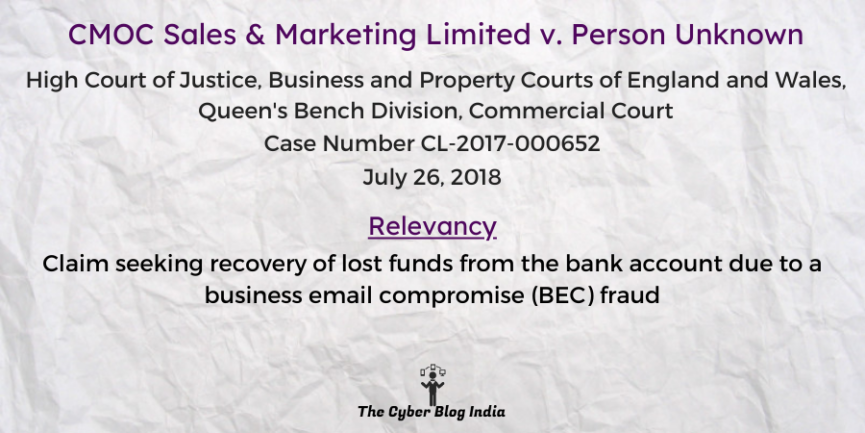CMOC Sales & Marketing Limited v. Person Unknown

CMOC Sales & Marketing Limited v. Person Unknown
[2018] EWHC 2230 (Comm)
In the High Court of Justice, Business and Property Courts of England and Wales, Queen’s Bench Division, Commercial Court
Case Number CL-2017-000652
Before Justice Waksman, QC
Decided on July 26, 2018
Relevancy of the case: Claim seeking recovery of lost funds from the bank account due to a business email compromise (BEC) fraud
Statutes and Provisions Involved
- The Senior Courts Act 1981 (Section 35(a))
- The Fraud Act 2000 (Section 2)
- The Computer Misuse Act 1990 (Section 1, 2)
Relevant Facts of the Case
- In 2017, CMOC, a company selling and purchasing Niobium, discovered a business email compromise fraud. The perpetrators hacked into the email of the Director, Mr Chen. They used the hacked email to send fraudulent payment instructions to the company’s bank, Bank of China (“the Bank”), in London.
- Consequently, the Bank transferred $6.91 million and €1.27 million through 20 transactions from the company’s account to 50 banks in 19 jurisdictions.
- CMOC initiated legal proceedings against 31 defendants soon after discovering the fraud. This led to a worldwide freezing order against an unidentified class of defendants clubbed as the first defendant.
- These other banks were enjoined as respondents to the disclosure proceedings. CMOC obtained information and disclosure orders against the banks to identify the particulars of the other defendants.
- None of the defendants filed a defence or acknowledgement of service, raising a strong obligation on the part of the claimant to make complete disclosures and fairly represent the case.
- The requirements for claims of dishonest assistance and unlawful means conspiracy (UMC) related to the fraudulent scheme where CMOC’s funds were misappropriated include the existence of a trust, breach of trust through unauthorised money transfer, and a must assistance in the breach.
- Assistance must be more than minimal and enable the breach. The liability is personal and coextensive, and the trustee’s is to restore the stolen money.
Prominent Arguments by the Counsels
- The claimant’s counsel argued that the defendants defrauded them of money, and they have a variety of claims against the defendants. These include proprietary claims, a claim for compensation for dishonest assistance, damages for unlawful means conspiracy (UMC), a claim in knowing receipt, and a claim in unjust enrichment.
- The defendants did not present their case.
Opinion of the Bench
- The claimant’s service and notification attempt to the defendants demonstrated that the defendants’ decision not to participate in the proceedings was informed and voluntary.
- An analysis of the bank statements indicates fraud, which the claimant has contended. One of the defendants handled a substantial part of the total amount involved.
- Bank accounts and account holders were in different countries during the entire incident. These bank accounts had a small amount in them before the transfer. Afterwards, they transferred the money to a large number of payees, with transactions happening very quickly. Therefore, CMOC has a proprietary claim over funds held by the defendants.
- The claimant has not classified between Level 1 and Level 2 payees. The benefit claimed for unjust enrichment cannot stand against any defendants.
- The claimant’s request to make the classification late in the trial can be allowed.
- The principle of compound interest will apply to dishonest assistant trustees as well.
Final Decision
- The court accepted the claim against Level 1 payees, i.e., the second to ninth, twelfth, twenty-sixth, and twenty-seventh defendants.
- The court awarded the proprietary claim and claim for knowing receipt in dishonest assistance at a compound interest of 2.5% per annum before compounding on six monthly rests.
Harmannat Kour, an undergraduate student at the Law School, University of Jammu, Jyotsna Sood, an undergraduate student at the National Law Institute University, Bhopal, Kashish Saxena, an undergraduate student at the National Law University, Jodhpur, and Nandita Karan Yadav, an undergraduate student at the National Law Institute University, Bhopal, prepared this case summary during their internship with The Cyber Blog India in May/June 2024.
